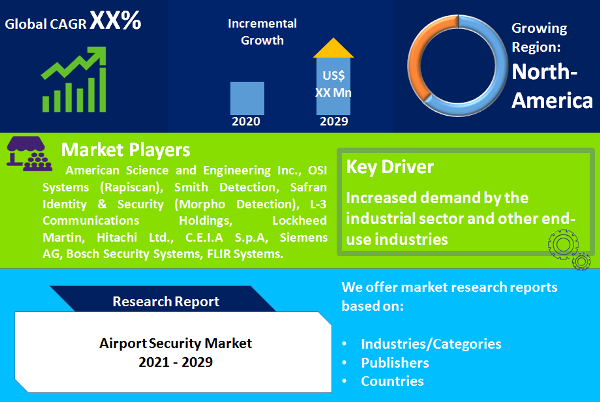
Report Scope
This report analyzes the global airport security market in terms of technologies deployed and geography. Based on technology, the global airport security market is segregated into surveillance, access control, perimeter security, screening, and cyber security among others. The geographical distribution of the global airport security market considered in this study encompasses regional markets such as North America, Europe, Asia Pacific, Middle East and Africa, and Latin America.
Overview:
Security concerns in view of growing terrorist threats coupled with the development of new airport projects with improved security infrastructure is identified as the major factor driving demand for airport security. Conformity with domestic as well as international aviation legislation is supporting the deployment of security technologies at airports. In addition, the market would also be benefited from the replacement of existing security systems with the advanced and smart versions. These factors are expected to contribute towards a steady growth during the forecast period 2021 – 2029. Issues including high upfront cost and constrained budgets are expected to pose moderate challenge to the market growth, especially during the first half of the forecast period.

1.1 Report Description
Purpose of the Report
The purpose of this strategic research study titled “Airport Security Market - Growth, Share, Opportunities, and Competitive Analysis, 2021 – 2029” is to offer industry investors, company executives, and industry participants with in-depth insights to enable them make informed strategic decisions related to the opportunities in the airport security market.
1.1.1 Target Audience
1.1.2 USP and Key Offerings
The report titled “Global Airport Security Market - Growth, Share, Opportunities, and Competitive Analysis, 2021 – 2029” offers strategic insights into the global airport security market along with the market size and estimates for the duration 2019 to 2029. The said research study covers in-depth analysis of multiple market segments based on technology and cross-sectional study across different geographies. In order to help strategic decision makers, the report also includes competitive profiling of the key industry participants, their SCOT (Strength, Challenges, Opportunities, and Weaknesses) analysis, market positioning, and recent developments. Other in-depth analysis provided in the report includes:
Overall, the research study provides a holistic view of the global airport security market, offering market size and estimates for the period from 2019 to 2029, keeping in mind the above mentioned factors.
In 2020, the screening segment was the largest revenue contributor to the global airport security market. The segment accounted for over 40% of the global market revenue and is anticipated to register steady growth during the forecast period 2021 – 2029. Under screening segment, metal detection remains the most commonly deployed security technology in current scenario. Cyber security represents one of the emerging airport security technologies and is presumed to drive future investments. Owing to the budgetary challenges faced by the airport authorities, they are bound to shift their focus away from the physical security technologies and embrace cyber attack mitigation and prevention measures in the near future. The airport authorities would be tempted to seek aid from the governments to strengthen their capability to manage cyber security attacks at the global scale.
In 2020, North America (comprising U.S. and Canada) was the largest airport security market worldwide. The region alone accounted for around one-third of the total market revenue worldwide in the same year. The U.S. represents the largest individual airport security market worldwide. The airport security market in the U.S. is primarily backed by the regulations and rigorous security measures adopted by the government in the wake of growing terrorism. The airport security market in North America is also expected to benefit from the replacement of out-of-date airport security systems with the advanced equivalents. On the other hand, Asia Pacific is expected to witness maximum growth during the forecast period. The anticipated growth would be majorly driven by the development of new airport projects coupled with improving security infrastructure in the region.
Historical & Forecast Period
This study report represents analysis of each segment from 2022 to 2032 considering 2023 as the base year. Compounded Annual Growth Rate (CAGR) for each of the respective segments estimated for the forecast period of 2024 to 2032.
The current report comprises of quantitative market estimations for each micro market for every geographical region and qualitative market analysis such as micro and macro environment analysis, market trends, competitive intelligence, segment analysis, porters five force model, top winning strategies, top investment markets, emerging trends and technological analysis, case studies, strategic conclusions and recommendations and other key market insights.
Research Methodology
The complete research study was conducted in three phases, namely: secondary research, primary research, and expert panel review. key data point that enables the estimation of Airport Security market are as follows:
Market forecast was performed through proprietary software that analyzes various qualitative and quantitative factors. Growth rate and CAGR were estimated through intensive secondary and primary research. Data triangulation across various data points provides accuracy across various analyzed market segments in the report. Application of both top down and bottom-up approach for validation of market estimation assures logical, methodical and mathematical consistency of the quantitative data.
| ATTRIBUTE | DETAILS |
|---|---|
| Research Period | 2022-2032 |
| Base Year | 2023 |
| Forecast Period | 2024-2032 |
| Historical Year | 2022 |
| Unit | USD Million |
| Segmentation | |
Technology
| |
|
Region Segment (2022-2032; US$ Million)
|
Key questions answered in this report